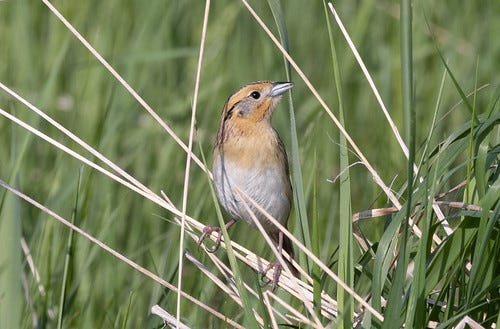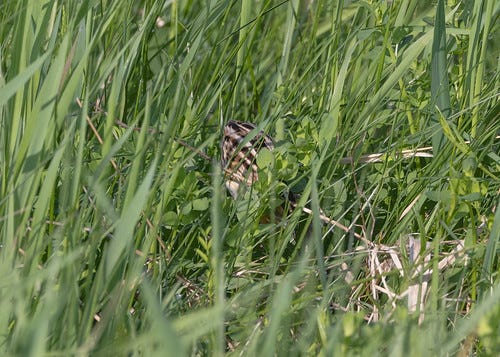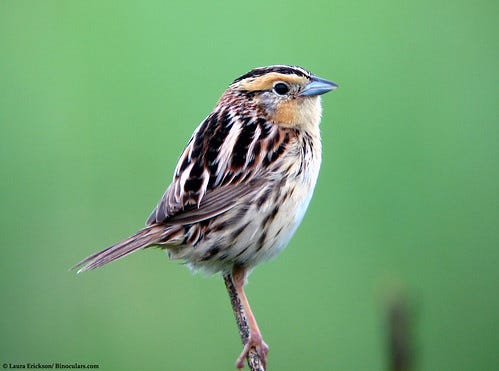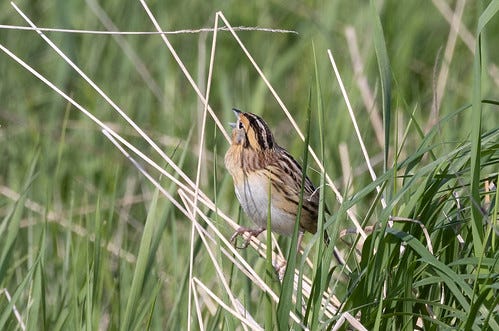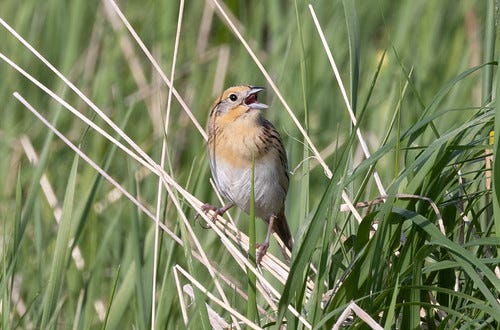(Listen to the radio version here.)
I gave a talk about my new book at the Sax-Zim Bog last week, and the Bog’s head naturalist, Clinton Dexter-Nienhaus, and his naturalist/birder wife Kristina offered to take me birding before my presentation. Of course I agreed! I was particularly yearning to see LeConte’s Sparrows. They’re a favorite of mine, but now that I’ve lost my high-frequency hearing, I can’t locate them on my own without headphones and a frequency-lowering device.
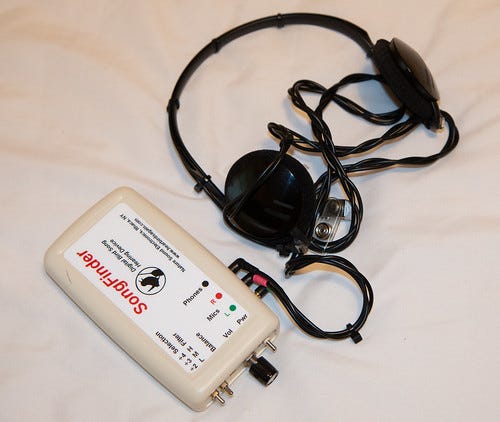
At about 7 am, Kristina and Clinton found a field with a nearby LeConte’s, and the moment they pointed, I saw it, too. LeConte’s Sparrows usually get from one spot to another by running, not flying, making them hard to track from one perch to another.
Fortunately, I could depend on Clinton’s and Kristina’s ears to relocate him. The early morning sunlight from behind us gave the bird a magical glow. We stayed at the edge of the road as I clicked away on my camera.
Seeing this most recent LeConte’s reminded me of the very first one I ever saw, on May 1, 1976, when Michigan’s Capital Area Audubon Society offered a weekend field trip to Whitefish Point.
Saturday morning started before first light at Michigan’s last prairie chicken dancing ground. After the display and breakfast at a small cafe, we headed to Hartwick Pines State Park and then made the four-hour drive to Whitefish Point, arriving about 1 pm to eat our sack lunches at the banding office. Everyone was hungry and tired after the long morning, but I was way too excited to stay inside, so I took my lunch to the gravel parking lot just in case.
The snow was still several feet deep in the woods, but the lot had been plowed and a few sparrows and finches were picking through the gravel and weeds for bits of food. One was tinier than the others, with a soft golden-orange face and breast and the most delicate cheek markings imaginable. I took in the black-and-white crown, the nape streaked with rows of delicate violet-brown, the bold blackish streaks on the back edged with pinkish brown and white, and side streaks that seemed to have been painted on not with a brush but a single fine horsehair. The tip of the short tail seemed jagged. The gray bill had a bluish-silver cast. Every detail seemed ethereal and magic.
The tiny thing was as exhausted and hungry from its arduous migratory flight as I was fascinated, so I sat down on a concrete parking barrier and started working my way through my Golden guide to figure out who it was. Arthur Singer’s illustration of a LeConte’s Sparrow seemed a bit dull but otherwise matched my bird perfectly, as did Chandler Robbins’s description, “Broad purplish collar, bright orange eye stripe, and white stripes through the crown distinguish this sparrow from all others.”
It was of course a lifer—#151 on my life list. I thought the others might be interested, so after drinking my fill of the gorgeous thing, I went inside to tell them.
The director of banding was at our table explaining the operations and what birds they’d banded that morning. I waited politely for a break in the conversation and then said I’d just seen a LeConte’s Sparrow in the parking lot. He looked at me—a 20-something, 90-pound girl who was obviously new at birding—and said that was impossible. LeConte’s Sparrow had never been recorded at Whitefish Point before.
Back then, I usually deferred instantly to anyone more experienced than me, and this man was a genuine authority on Whitefish Point birds, but I’d studied this bird carefully and looked at every other species to make sure there weren’t alternatives, so I did something unprecedented: I argued with him. I was polite but insistent. Our field trip leader, Joan Brigham, believed me and headed to the parking lot with our group—the bander reluctantly followed. Luckily, the bird was still there. After one glimpse, the bander charged at top speed back to the building, yelled to the staff that he’d found a LeConte’s Sparrow in the parking lot, and grabbed a mist net.
After he set up the net on the far side of the bird, he instructed us to form a semi-circle and slowly walk toward it to flush it into the net. I’d never before seen a bird get trapped and banded. When he carefully and gently extricated the tiny mite from the net, he held it for all of us to see. His hand was enormous, and with a dozen pairs of eyes gawking, I thought the poor thing must be terrified, but it glared at him and opened its bill as if in fury and defiance. My brain instantly jumped to Ahab confronting Moby Dick himself.
Being attracted to both numbers and literature, I headed to the university library the moment it opened on Monday to do a bit of research. It was easy enough to look up what LeConte’s Sparrows weigh—about 13 grams. And one encyclopedia reported the maximum weight of a sperm whale as 63 tons. But how much did Ahab weigh? Herman Melville had been dead for 85 years so I could hardly ask him. I found a fan magazine with data on the next best thing: Gregory Peck, who apparently weighed 174 pounds. I’m sure that was less than the bird bander weighed, but that put my hypothetical Ahab closer to the sparrow and further from the whale. From these numbers I worked out the ratios:
Yep. Le Conte’s Sparrow was tinier, relative to Ahab, than Ahab would have been compared to the Great White Whale—and not just by a little. The biggest sperm whales weigh 724 times as much as Gregory Peck’s reported weight, but his weight was fully 6,000 times a Le Conte’s Sparrow’s—an order of magnitude difference!
Of course, the Moby Dick in this scenario didn’t bite off tiny Ahab’s leg, but he did place a numbered aluminum U.S. Fish and Wildlife Service band on the leg as a permanent reminder of their encounter. And tiny Ahab didn’t throw harpoons and knives at Moby Dick the bander, but did bite his finger hard enough to draw a drop of blood. Now, 47 years later, I, Ishmael in this scenario, alone am escaped to tell thee.





